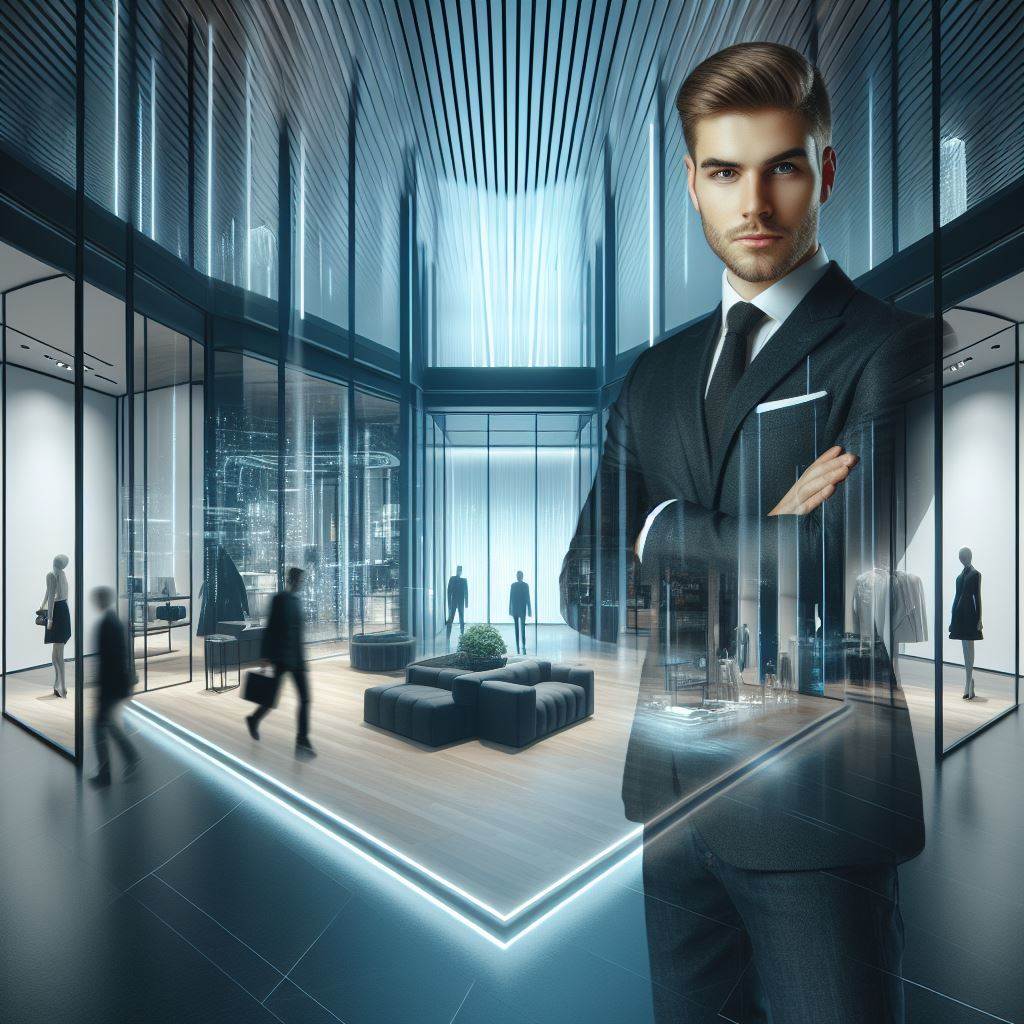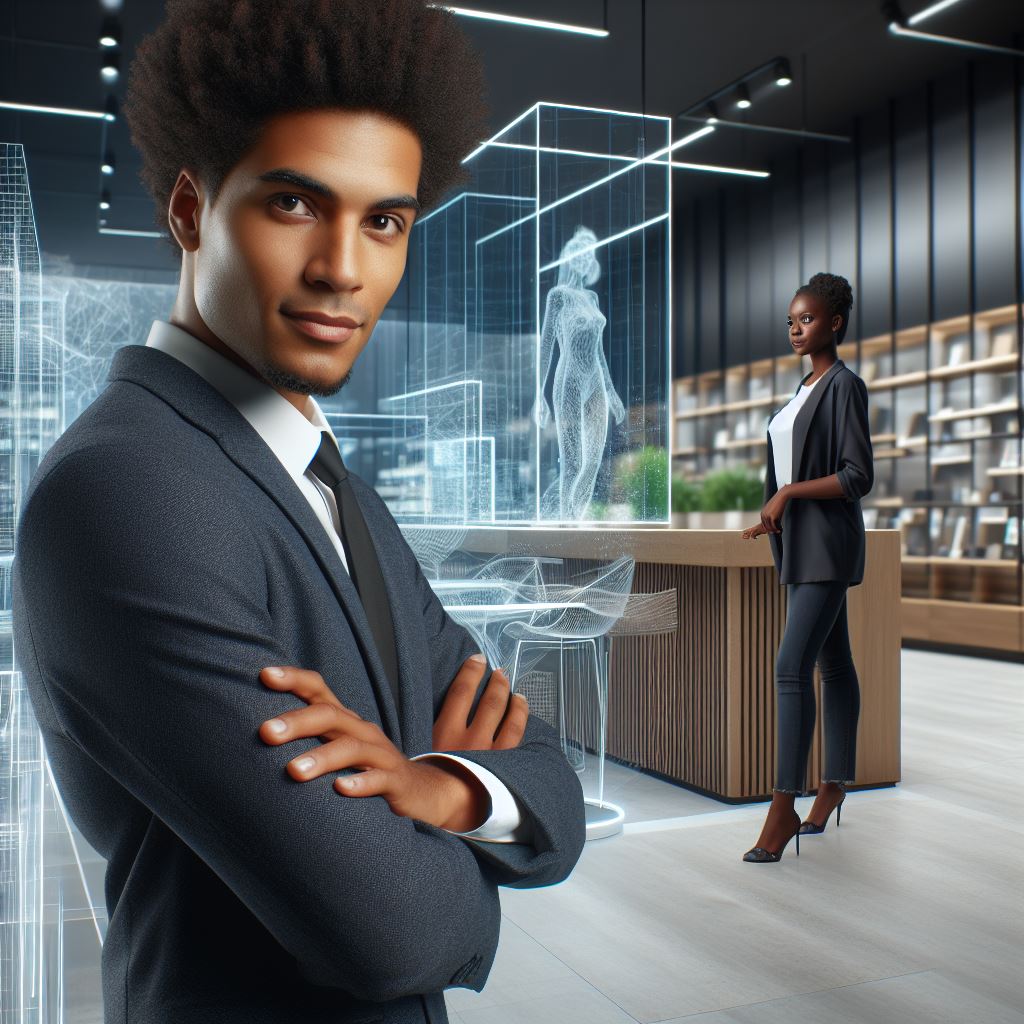Introduction
Retail store design plays a crucial role in attracting customers and creating a memorable shopping experience.
In an ever-evolving retail industry, businesses need to constantly update their store designs to stay relevant.
The purpose of this blog post is to discuss the emerging trends that will shape retail store design in 2024.
As shoppers’ preferences and expectations evolve, it is essential for retailers to adapt and create spaces that cater to their needs.
By keeping up with the latest trends, businesses can differentiate themselves from competitors and create a unique shopping experience.
One of the key trends in retail store design is the integration of technology.
With advancements like augmented reality and smart mirrors, retailers can enhance the shopping experience by providing interactive and personalized features.
Another trend is the focus on sustainability and eco-friendly designs.
Customers are increasingly conscious of the environmental impact of their purchases, and retailers can attract them by incorporating sustainable materials, energy-efficient lighting, and green initiatives into their store layouts.
Furthermore, the concept of experiential retail continues to gain momentum.
Retailers can create immersive experiences by incorporating elements such as pop-up installations, interactive displays, and sensory branding.
These experiences go beyond traditional shopping and leave a lasting impression on customers.
In essence, retail store design plays a crucial role in attracting and retaining customers in the ever-evolving retail industry.
By staying updated with the emerging trends in 2024, businesses can create unique and memorable shopping experiences that set them apart from competitors.
Integration of Technology
In 2024, the retail landscape is evolving rapidly, with technological advancements driving major shifts in store design.
Let’s delve deeper into the key aspects shaping this transformation:
Integration of Technology in Retail Store Design
The integration of technology is revolutionizing traditional retail store layouts. Gone are the days of static displays and mundane shopping experiences.
Instead, retailers are embracing cutting-edge technologies to create dynamic and engaging environments for customers.
Interactive displays are at the forefront of this revolution.
These displays allow customers to interact directly with products, providing a hands-on experience that enhances their understanding and appreciation of the merchandise.
Whether it’s swiping through different color options or virtually trying on clothing, interactive displays bring a new level of interactivity to the shopping process.
Augmented reality (AR) is another game-changer in retail store design.
By overlaying digital information onto the physical world, AR technology blurs the line between the online and offline shopping experience.
Customers can use their smartphones or AR glasses to see additional product information, reviews, or even virtual models showcasing how items would look in real life.
Virtual reality (VR) takes immersion to the next level.
Retailers are using VR technology to create virtual shopping environments where customers can explore products in a completely simulated setting.
From touring a virtual showroom to experiencing a virtual fitting room, VR transports shoppers to new worlds, allowing them to interact with products in ways never before possible.
Seamless Online-Offline Integration
In today’s digital age, the distinction between online and offline shopping is becoming increasingly blurred.
Retailers recognize the importance of seamlessly integrating these two channels to provide a cohesive and convenient shopping experience for customers.
One of the key strategies for achieving this integration is offering in-store pickup for online orders.
This allows customers to shop online and then conveniently collect their purchases from a physical store location.
Not only does this save on shipping costs and delivery times, but it also encourages customers to visit the store, potentially leading to additional purchases.
Furthermore, retailers are leveraging technologies such as mobile apps and RFID tags to bridge the gap between online and offline shopping.
Mobile apps allow customers to browse products, check inventory, and make purchases both in-store and online, creating a seamless shopping experience across channels.
RFID tags enable retailers to track inventory in real-time, ensuring that customers can easily find the products they want, whether they’re shopping in-store or online.
In summary, the integration of technology is revolutionizing retail store design in 2024.
From interactive displays and augmented reality to seamless online-offline integration, retailers are leveraging cutting-edge technologies to create immersive and convenient shopping experiences for customers.
As technology continues to evolve, so too will the retail landscape, with innovation driving the future of store design.
Read: Shopping Mall Revival: Strategies That Work
Sustainability and Eco-Friendly Design
In recent years, there has been a growing awareness about the importance of sustainability in retail store design.
Consumers are becoming more conscious of their impact on the environment and are actively seeking out brands and stores that share their environmental values.
Use of Eco-Friendly Materials
One of the key trends shaping retail store design in 2024 is the use of eco-friendly materials.
Retailers are opting for sustainable materials such as reclaimed wood, recycled plastics, and organic textiles.
By using these materials, stores can not only reduce their carbon footprint but also create a unique and visually appealing shopping environment.
Eco-friendly materials give a store a distinct identity and attract environmentally conscious customers.
Energy-Efficient Lighting
Another aspect of sustainable retail store design is the use of energy-efficient lighting.
Traditional lighting options such as incandescent bulbs are being replaced by LED lights that consume significantly less energy.
LED lights not only help reduce energy consumption but also last longer, resulting in lower maintenance costs for retailers.
These lighting solutions offer superior brightness and color rendering, enhancing the overall shopping experience for customers.
Green Building Practices
Retailers are increasingly adopting green building practices to ensure their stores have a minimal impact on the environment.
This includes using renewable energy sources, implementing efficient heating and cooling systems, and installing water-saving fixtures.
Green buildings are designed to be sustainable in the long run, reducing energy consumption and minimizing waste generation.
These practices not only benefit the environment but also demonstrate a brand’s commitment to sustainable business practices.
Rising Consumer Demand for Environmentally Conscious Brands
Consumers today are more informed and aware of the environmental impact of their purchasing decisions.
As a result, there is a rising demand for environmentally conscious brands and stores that align with their values.
Retailers that prioritize sustainability and eco-friendly design are likely to attract a loyal customer base.
Consumers are willing to spend more on products and services from brands that are actively working towards reducing their environmental footprint.
Environmentally Conscious Stores as Competitive Advantage
Embracing sustainability in retail store design is no longer just a moral obligation; it has become a competitive advantage.
Brands that can showcase their eco-friendly practices and initiatives can differentiate themselves from their competitors.
By incorporating sustainable materials, energy-efficient lighting, and green building practices, retailers can create a shopping experience that resonates with environmentally conscious consumers.
This can lead to increased footfall, higher customer satisfaction, and ultimately, greater profitability.
As we move towards 2024, it is evident that sustainability and eco-friendly design will play a crucial role in shaping the retail landscape.
By adopting environmentally conscious practices, retailers can not only address consumer demands but also contribute to a greener future.
Read: High-Tech Malls: The New Face of US Retail
Focus on Personalization
In 2024, the retail landscape is witnessing a significant shift towards personalization, where stores are increasingly tailoring their offerings and experiences to meet the unique preferences of individual customers.
This shift reflects a deeper understanding of consumer behavior and the acknowledgment that one size does not fit all in retail.
Understanding Individual Preferences
Retailers are investing more resources into understanding the specific preferences of their customers.
Through various means such as surveys, feedback forms, and data analysis, they gather insights into what each customer likes, dislikes, and expects from their shopping experience.
This understanding forms the foundation of personalized offerings.
Leveraging Customer Data and Analytics
Customer data and analytics play a crucial role in driving personalization efforts.
Retailers collect vast amounts of data, including purchase history, browsing behavior, and demographic information.
Sophisticated analytics tools help extract meaningful insights from this data, enabling retailers to offer personalized recommendations and targeted promotions.
Implementing Customizable Products and Experiences
In response to growing demand for personalized offerings, retailers are increasingly introducing customizable products and experiences.
Customers can now personalize various aspects of their purchases, from clothing and accessories to electronics and home decor.
This customization extends beyond products to encompass the entire shopping experience, with retailers offering personalized assistance, tailored recommendations, and curated displays.
Overall, the focus on personalization represents a paradigm shift in retail, where the customer takes center stage.
By understanding individual preferences, leveraging data-driven insights, and implementing customizable offerings, retailers can create more engaging and meaningful experiences for their customers.
This not only fosters customer loyalty but also drives business growth in an increasingly competitive market landscape.
Read: Future of Shopping Centers: Post-COVID Outlook

Integration of Social Spaces
The trend of incorporating social spaces within retail stores to create a sense of community
In recent years, there has been a growing trend in the retail industry – the integration of social spaces within retail stores.
This trend aims to create a sense of community and provide customers with more than just a shopping experience.
Retailers have started incorporating cafes, lounges, and interactive areas within their stores.
These spaces provide customers with the opportunity to relax, socialize, and spend more time within the store premises.
By offering these social spaces, retailers are able to engage customers on a deeper level, creating a bond that goes beyond transactions.
Inclusion of cafes, lounges, and interactive areas for customers to relax and socialize
The inclusion of cafes within retail stores has become increasingly popular.
Customers can enjoy a cup of coffee or a quick bite to eat while taking a break from their shopping activities.
These cafes often have a cozy and inviting atmosphere, encouraging customers to stay longer and further explore the store’s offerings.
Lounges are another social space that retailers are embracing.
These lounges provide a comfortable seating area where customers can take a break, try on merchandise, or simply relax.
Retailers are taking extra steps to ensure that these lounges are well-designed and aesthetically pleasing, creating a warm and inviting ambiance.
Interactive areas are also becoming more common in retail stores. These areas are designed to engage customers and enhance their overall shopping experience.
Examples of interactive spaces include gaming zones, virtual reality stations, and interactive product displays.
These features not only entertain customers but also provide them with valuable information about the products and the brand.
Use of events and workshops to foster engagement and build customer loyalty
To further foster engagement and build customer loyalty, many retailers are organizing events and workshops within their stores.
These events range from product launches to educational workshops and even community gatherings.
By hosting these events, retailers create opportunities for customers to interact with each other and with the brand on a more personal level.
The integration of social spaces within retail stores is not only beneficial for customers but also for retailers themselves.
By providing spaces for customers to relax and socialize, retailers can increase the amount of time customers spend in their stores.
This extended time not only boosts the chances of making a sale but also presents opportunities for retailers to upsell and cross-sell their products.
Moreover, these social spaces create a sense of community among customers, making them feel more connected to the brand.
This sense of community can lead to repeat visits and increased customer loyalty.
When customers feel like they are part of a community, they are more likely to recommend the store to their friends and family, further expanding the store’s customer base.
In general, the integration of social spaces within retail stores is a trend that is shaping the industry.
By incorporating cafes, lounges, interactive areas, and hosting events, retailers are creating a sense of community and fostering engagement.
These social spaces not only enhance the shopping experience but also contribute to the overall success of the retail store.
Read: 2024 Retail Spaces: Trends in US Malls & Stores
Flexible Store Layouts
The retail industry is constantly evolving, and in order to remain competitive, store owners must adapt to changing customer needs.
One of the key trends shaping the future of retail store design is the move towards flexible store layouts.
Embracing Change to Meet Evolving Customer Needs
In 2024, the retail industry is witnessing a significant shift towards flexible store layouts.
This movement stems from a deep understanding of the evolving needs and preferences of modern consumers.
Retailers are realizing that static, traditional store designs are no longer sufficient to capture the attention and loyalty of today’s dynamic shoppers.
Consumers are seeking more than just products; they crave immersive experiences and personalized interactions.
Flexible layouts allow retailers to cater to these desires by adapting their physical spaces to align with changing trends and consumer behaviors.
Whether it’s a sudden surge in demand for a particular product category or a shift in shopping patterns, flexible store layouts enable retailers to respond swiftly and effectively.
By embracing change and embracing flexibility in their store designs, retailers can stay agile and responsive to the ever-changing retail landscape.
This proactive approach not only enhances the overall shopping experience but also strengthens customer engagement and loyalty.
Dynamic Displays: Creating Engaging Store Experiences
One of the key advantages of flexible store layouts is the ability to easily rearrange displays and shelves.
This flexibility empowers retailers to create dynamic and engaging store experiences that captivate customers’ attention and drive sales.
Gone are the days of static, uninspiring displays that remain unchanged for months on end.
In 2024, retailers are leveraging the power of dynamic displays to create excitement and novelty in their stores.
By regularly refreshing and rearranging product displays, retailers can keep the shopping environment fresh and inviting, encouraging customers to explore and discover new products.
Dynamic displays also allow retailers to showcase products in different ways, highlighting key features and benefits to attract shoppers’ interest.
Whether it’s through creative merchandising techniques or interactive product demonstrations, dynamic displays enable retailers to tell compelling stories that resonate with customers on a deeper level.
Versatile Spaces: Adapting to Changing Needs
In today’s fast-paced retail environment, versatility is key. Retailers need spaces that can easily adapt to accommodate a variety of functions and purposes.
This is where flexible store layouts shine, offering adaptable spaces that can be transformed to meet changing needs and trends.
From hosting events and workshops to accommodating pop-up shops and temporary installations, adaptable spaces enable retailers to maximize the utility of their physical stores.
By seamlessly transitioning between different setups, retailers can create memorable experiences that resonate with customers long after they leave the store.
Moreover, versatile spaces also offer retailers the flexibility to experiment and innovate, testing new concepts and initiatives without committing to permanent changes.
This agility is invaluable in today’s competitive retail landscape, allowing retailers to stay ahead of the curve and delight customers with fresh, exciting experiences.
Conclusion
This blog post has discussed several key trends shaping retail store design in 2024.
These trends include the prioritization of sustainability, the integration of technology, the rise of experiential retail, and the shift towards personalized and customer-centric designs.
Staying updated with these trends is crucial for retailers to remain competitive in the ever-evolving retail industry.
By ensuring their store designs align with these trends, retailers can attract and retain customers, enhance their brand image, and drive sales.
I encourage readers to incorporate these trends into their own retail store designs.
By embracing sustainability, leveraging technology, creating immersive experiences, and prioritizing personalization, retailers can create a successful and customer-centric future.
It is essential to adapt and evolve with the shifting demands and preferences of consumers.
Incorporating these trends will not only attract new customers but also keep existing customers engaged and loyal.
Retailers who fail to adapt may risk falling behind their competitors and losing market share.
By implementing these trends in their retail store designs, retailers can create memorable and impactful experiences for their customers.
This will ultimately lead to increased footfall, higher sales, and a strong competitive advantage in the retail industry.
So, whether you are a small boutique or a large department store, it is essential to stay updated and embrace these trends.
Your retail store design is a reflection of your brand, and by incorporating these trends, you can ensure a successful and customer-centric future.




